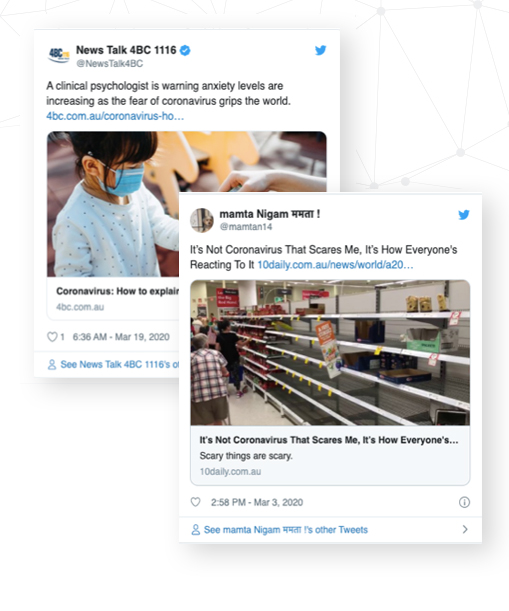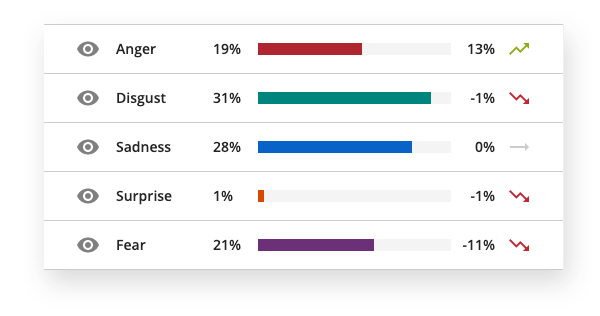Why you should consider socially distancing your brand from COVID19.
SuperNova">SuperNova
We know it is happening and we know it is everywhere, but do we really need to be contributing to this when it isn’t our place?
A few days ago I had a panic attack. It wasn’t my first, but it was the first in quite some time. The build-up of all of the news, social media conversation and messages by brands I was being exposed to had me feeling completely and utterly overwhelmed. I think the straw that broke the camel’s back was when I walked into a Coles with a colleague to get a few things for the office and saw the absolute chaos firsthand.
Of course it had been building up to this for a little over a week; the emptying of shelves, people pretending it was just a normal shop when everyone knew that it wasn’t, but on the exterior, keeping our pretend cool. But this time, it was different. Every shelf had pretty much been stripped bare, and people were clearly done keeping their cool. They were walking fast, ignoring usual social pleasantries as they focused on what they needed, even if it meant pushing other people out of the way to get it. I walked out and the panic attack soon followed.

What was happening? Everything I was reading, hearing and watching had me completely overcome. At that moment I decided (with a little push from my husband) that it was time to reduce the noise. I may not be able to control how much of this I am able to handle but I can make a choice as to how much of this I will be consuming.
We know it is happening and we know it is everywhere, but do we really need to be contributing to this when it isn’t our place? Do we need to be pushed with un-subtle messages from various health brands on ‘immunity building’ supplements? Do we need to be reading content that clearly has an underlying agenda to SELL based on people’s anxiousness and feelings of uncertainty? Do we really need to hear from brands that aren’t relevant but are feeling the need to contribute to the conversation? Unless you have a relevant message that aids our community then perhaps, just don’t. Maybe all of this isn’t actually helping, maybe it’s hurting? What and how much do people actually want to hear?
As the agency partner for Brandwatch, we tapped into around 1.9 million+ pieces of online content across Australia since the beginning of March to understand what people are saying and how they are feeling. We can see that the emotion around the COVID-19 conversation is switching from fear to anger. People are getting saturated with content and with so many differing statistics and views people are getting frustrated with the politics, confusion and wanting different action taken to overcome implications of this virus. Do brands want to be associated with content causing this sort of emotional reaction?

Social media is designed to keep people on the platform, that’s what their UX team is tasked mainly to do. We are now in a time where this is working for and against us, as social platforms are not only a way to connect with loved ones in a time where we are isolated, but it also means that with all of this extra time we are consuming anxiety-fueling content more than ever. As brands that are present in media, we have a responsibility to support when it is our place to, but also to keep away if it is only going to add to the problem.
There will be great opportunities for advertisers to take advantage of increased audiences across platforms we expect to do well while people are at home. So be there as you usually would if appropriate but stay away from conversations that you don’t have a need to be contributing to. If you can support and add value, even better. Brands that can do this genuinely will be well remembered after this is all over. The Coles campaign featuring Curtis Stone is a great example of how to do it right. But not only do they have a brand that is relevant and able to do it, they actually need to in order to support their staff and our community.
From a communications point of view, not only do you need to optimise placement to align with changing media consumption, you also need to make sure the message is relevant for each platform and adds value to the audience more than ever. We need to think about how we can use social to add value to connections rather than fueling the COVID-19 forums and debates. If you have spots surrounding news content, how can we make sure messages in between aren’t only ones talking more about what audiences are already watching. How can we lead with normalcy, positivity and innovative ways to continue with products or services that may otherwise become obsolete.
There are far more opportunities to stand out applying this strategy than being just another voice or opinion in an already over saturated topic. People are looking for ways to disconnect and if you can provide them with this in a way that takes current issues and sensitivities into consideration then go for it. It is extremely important your media and creative agencies are working closely together to be able to develop the right strategies’ to do this properly and get to market quickly if you need to change course.
Finally, we recommend using this time to innovate in this new world we all find ourselves living in and creating sustainable strategies to ensure growth as we move forward. The worst thing we can do as marketers is think of ways to get campaigns live quickly enough to be involved in the conversation before it becomes irrelevant. Just ask yourself if people actually consider or need your brand to be relevant throughout this in the first place.
Please feel free to reach out here if you have any questions. Our team at SuperNova can help you identify and implement the right strategies for your business.

